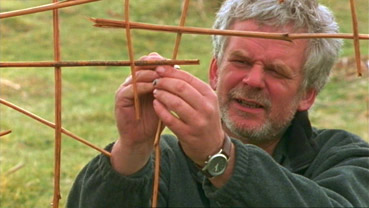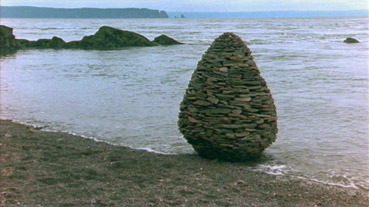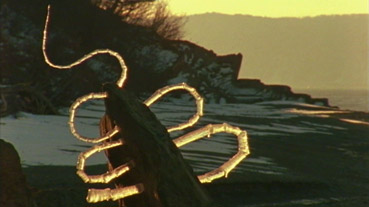| "I
don't think the Earth needs me at all. But I do need it." |
| Andy Goldsworthy |
If
you are seriously interested in art, you'll already be familiar
with the work of Andy Goldsworthy, a British artist who
works exclusively with found objects, creating his pieces in and from nature. Very few achieve any
sort of permanence, often being reclaimed by the landscape
and the elements in a fraction of the time it took to create
them, the only record of their existence being photographs
that Goldsworthy himself takes. A man who usually works
alone in often isolated conditions, Goldsworthy is by his
own admission not a people person, and perhaps the most
remarkable achievement of Thomas Riedelsheimer's wonderful
documentary is how intimate a bond the director appears
to form with him, and how close we, as an audience, are
subsequently drawn into his world and his approach to his
art.
Subtitled
Andy Goldsworthy: Working With Time, it
is this aspect that the film successfully explores in a
way that Goldsworthy's own photographs cannot, with both the
time spent on the creation of a work and its sometimes fleeting
existence vividly captured here. Despite the
semi-abstract nature of his works, the effort Goldsworthy
invests into them is probably easier for an audience to
connect with than that of a more studio-based artist. Often
involving long hours of physical labour and repetative toil,
his anguish when a wind change destroys a complex and delicate
construction provokes an empathathic response that few would
feel for a painter rubbing his head in dismay because that
particular shade of red just isn't working for him. The
physicality of Goldsworthy's effort is seen particularly
in his fingers, which are constantly blackened from bruises
and adorned with Elastoplast. He doesn't like to wear gloves,
he tells us when working for hours with ice, as he needs
to feel the texture of his materials.

Goldsworthy
is remarkable in part for being able to look at a leaf,
a rock or a piece of wood and not only visualise it transformed
into something abstractly beautiful, but also for having the know-how required to effect that transformation. A lovely example of
this comes early on in the film, when he travels to Nova Scotia to work
on a new commission (for whom we are never told, and I for
one was curious about this, given the very temporary nature
of his pieces). He starts by using icicles – broken
off from their original location and joined by warming the
ends in water and freezing them to the next piece of the
sculpture – to create the snake-like shape that has become
a familiar icon in his work. That it is constructed to
appear as if it is passing through a rock is interesting,
but there is still a sense that this is a minor piece,
that is until the sun rises the following morning and illuminates
the ice sculpture like a twisted strip of neon. The effect
is breathtaking, and its beauty catches even Goldsworthy by
surprise. A short while later the piece is melting away,
lost to the surroundings that gave birth to its component
parts. Similarly, the spiral wooden 'whirlpool' he creates
in the same location that is so admired by a passing local
has only a few hours to live before being washed away by
the tide, a process that Riedelsheimer's camera observes
in loving detail.
It
is extraordinary how closely we connect with Goldsworthy,
his complete and utter dedication to the creation of each
piece prompting much more than just admiration for his persistence.
Less than 20 minutes in, he starts work on creating a large
cone from nearby slabs of rock on a shoreline that will
be under water in a matter of hours. Here he is not so much
working with time as against it (indeed, at one point he suggests that
Riedelsheimer "stop filming and collect stones instead
– do something useful"), and is approximately one third
of the way through its construction when it suddenly
collapses. I was genuinely wound up by this, and when a
second one showed signs of doing likewise I was actually
chewing my fingernails with tension. This was during my first
cinema viewing of the film, but to my surprise I had exactly
the same reaction when watching it again on DVD. I wanted
Goldsworthy to succeed so much, understood so well the pain
of working for so long on something only to have it fail,
that I had complete empathy with him. You don't have to
be an artist to understand how he feels as he lets
let out an anguished "Shit!" as this second (actually,
as we discover, the fourth) cone suddenly falters. There is
a real sense of triumph when the final one not only stands,
but even after being completely submerged by the tide, it remains intact.

It
helps that Goldsworthy, despite, or in part perhaps because
of his total dedication his art, is immensely likable, and a long way from the brashly over-confident Young
British Artists targeted by the likes of Private Eye. He
talks throughout about his work, sometimes to camera, sometimes
in voiceover, and though occasionally may seem to be bordering
on pretension he is always sincere. When he says something
like "I feel as if I have touched the heart of the
place," you kind of know what he means.
In the first half-hour, Riedelsheimer paints a compelling
portrait of what could almost be an artistic cliché, the serious, slightly out-there isolationist, working alone
and unapproachable by normal mortals, an image that is most unexpectedly shattered on Goldsworthy's return to his home
in Penpont in Scotland. Having watched him break
down laughing at an Alpine cow that is disrupting his attempt
to explain the artistic appeal of a particular plant, we are then introduced to the noisy, semi-chaotic
nature of his home-life. Far from the isolated loner, Goldsworthy
is a dedicated family man who jokes with his wife about
his work and plays enthusiastically with his kids. He is
also very much part of the local community, with which he
openly interacts. That said, he later confirms that he enjoys
being on his own, and can find interaction with people "draining."
Riedelsheimer
– who as well as directing also shot and edited the movie
– creates moving images that do justice to Goldsworthy's work, exploring them them in
very cinematic detail, drifting over them in floating SteadiCam shots and
elegantly executed pans, cranes and tracks. When works are
framed motionlessly, Riedelsheimer still adds a cinematic
element, as on the field-located stone cone that, through
a series of time-dissolves, we watch become gradually obscured by plant life.
Fred Frith's music score, which moves from celtic themes
to an almost avante-garde use of single notes and percussion,
effectively emphasises the beauty and simple purity of the artwork, as well as providing the key scenes with an almost
other-worldly atmosphere. The music also most effectively
underscores the tension in the aforementioned cone creation
sequence.
The
motivation and dedication that drives individual artists
has been a subject for a fair number of Hollywood and independent
films, but despite some notable near misses – Ed Harris's
Pollock would certainly qualify here –
they have never completely nailed it because of the need
to conform to the perceived expectations of a largely mainstream
audience. Thomas Riedelsheimer's beautifully executed documentary
gets as close to understanding the artist and his art as
any film I've seen. Inevitably, it is not as overwhelmingly
effective on DVD as it was sitting in the front row of a
cinema, where the imagery fills your field of vision, but
it still makes for compelling, inspirational viewing, and
helps immeasurably to appreciate the dedication, patience
and effort that can go into a work that, for just
a few hours, minutes, or even seconds, really will take your breath
away.
This
is the German region 0 disk from Absolut Median, at the
time of writing the only DVD available of the film.

Presented
in 1.78:1 anamorphic video, this is a reasonable but less
than perfect transfer. A single layer disk, there are sometimes
quite evident compression artefacts in large areas of single
colour, usually grays. The contrast is variable – sometimes
it is very pleasing, but there are a fair few scenes where
the solid blacks we expect from DVD are not really there.
Colours are generally good without being outstanding. Some
of these issues are down to the restrictions of filming
Goldsworthy in a rain-soaked Scottish field, where contrast
levels are going to be low anyway, but having only recently
viewed the film on a cinema screen I feel sure a better
job could have been done. It's a serviceable presentation,
but Goldsworthy's (and Riedelsheimer's) work deserves the
best possible transfer – the sharpest picture, the finest
contrast, the most beautifully rendered colours.
There
are two soundtracks available, both of them Dolby 2.0, one
the original English, the other a German dub. A 5.1 mix
would really have added to the experience, with the sounds
of nature and Fred Frith's music so key to the atmosphere
of the piece. Once again, a serviceable rather than outstanding
job.
There
a a very small number of extras here, but the arrangement
of the menus and sub-menus initially fools you into thinking
there are a few more.
The
Gallery option offers two further features, Gallery
Register and Photo Gallery. Both are
useful to a limited degree. Gallery Register lists
all of the artworks created by Goldsworthy in the film (in
German, of course) and provides links to the chapters in
which they appear. The Photo Gallery consists of
just 16 photographs, half screen size, a mixture of publicity
shots and behind-the-scenes pictures of Riedelsheimer at
work. Though small, these are rather good, as they
do show how the director achieved some of his drifting camera
shots (a Pro Jib mounted on a tripod is both flexible and
rather portable).
The
Production Notes give brief background information
on the making of the film, but are in German, so you will
need to know the lingo to make use of them. The same goes
for the Biographies of Goldsworthy, Riedelsheimer
and Frith, and the brief extracts from Reviews.
Soundtrack
is a simple promo for the soundtrack CD, accompanied by one
of the Celtic themes from the film, and provides a web site
URL for you to visit (and possibly buy from). Links
lists some further URLS of sites that contain information
on the film. Finally Credits DVD lists, well, the
DVD credits.
Rivers
and Tides is a spellbinding portrait of a unique and
dedicated artist and absolutely should be seen by anyone
with even a passing interest in the possibilities of an
alternative approach to art. Despite the indoor construction
of one extraordinary piece – a huge clay wall whose intricate
construction is impossible to appreciate until it starts
to dry – Goldsworthy's work challenges the idea that art
has to be put on public display to have value, and indeed
suggests that it need exist for no more than a few seconds
to achieve importance and beauty. Riedelsheimer clearly
recognises that, and his film does not merely observe the
artist at work, it both understands and celebrates him through
its own, particular beauty.
At
the time of writing, Absolut Median's German region 0 disk
is the only DVD available of the film, so it's something
of a one-horse race at present. Rivers and Tides
is no Hollywood blockbuster nor indie sleeper, and it would
take a determined distributor to strike a new transfer and
remix the sound. But I would hope that somewhere out there,
someone feels it would be worthwhile – the quality of the
film alone may just inspire someone in the right position
in a sympathetic DVD distribution company to want to do
the film justice. In the meantime, this is an adequate
if uninspiring disk, and is still preferable to not
having the film. If by some fluke you can catch it on the
big screen, then do so, as that's where it belongs, but
otherwise this DVD will have to do, and you could still
do a lot worse.
|